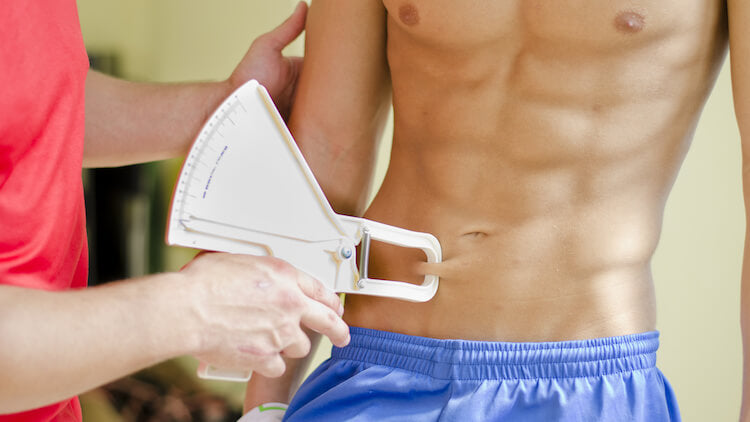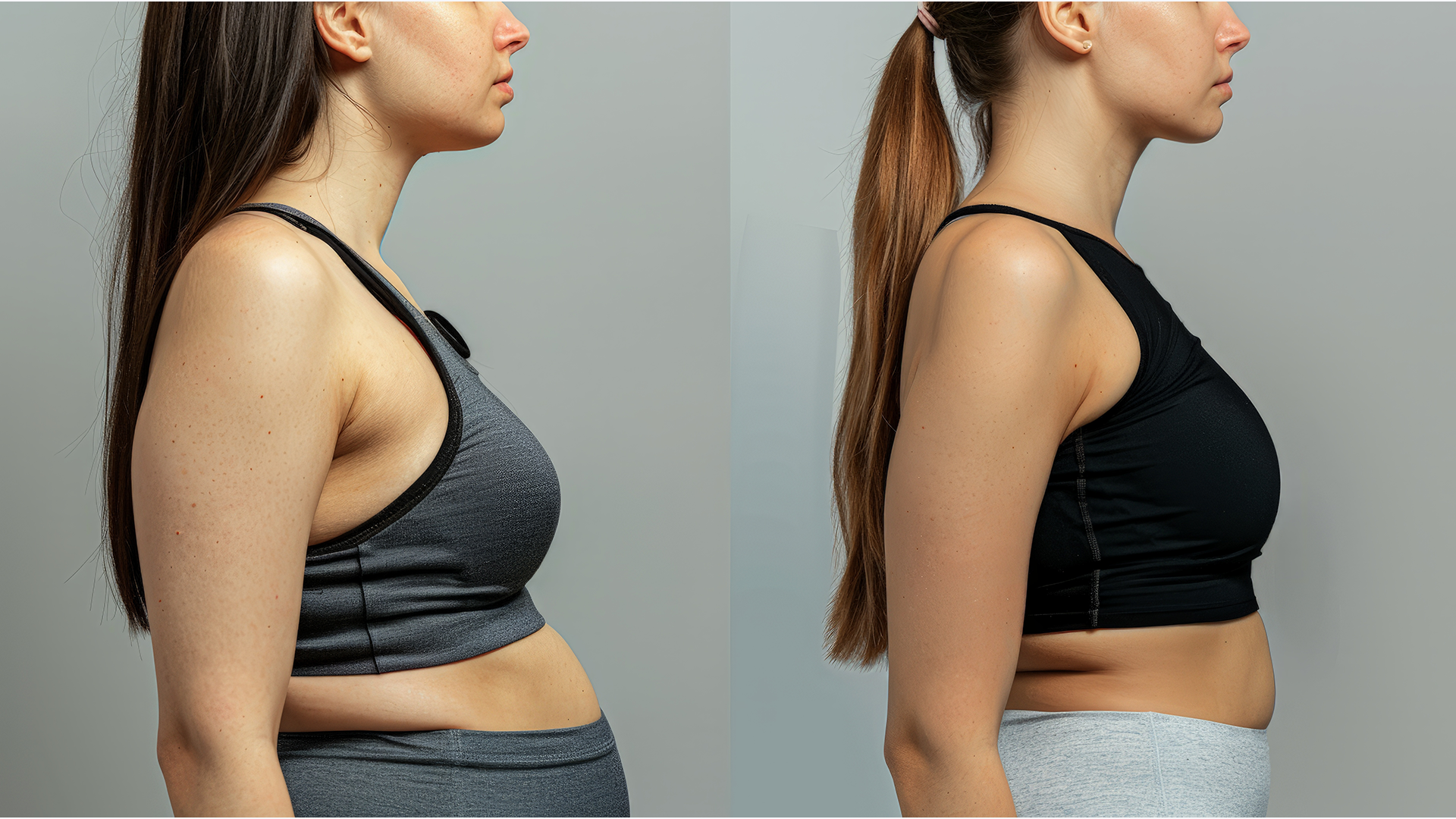Body fat percentage calculations are a core component of losing weight without compromising long-term well being. There are multiple ways to calculate body fat percentage and to use it as a way to plan out your lifestyle.
With these figures, you can create your workout goals and nutrition plans to reach the best shape of your life. The following article offers comprehensive guidance on the importance of body fat calculations and the ways in which you can calculate yours.
- What is body fat percentage
- Why is it important to know your body fat percentage?
- What’s a Healthy Body Fat Percentage for Men and Women?
- What’s the Lowest Body Fat Percentage You Can Maintain?
- How different % of body fat looks like
- Methods of Measuring Body Fat Percentage
- Body Fat Percentage Compared to The Body Mass Index (BMI): The Differences
- Effective ways to lower body fat %

What is body fat percentage
Mathematically speaking, you can measure your body fat percentage through the following formula:
This number basically tells you how much of your total mass is fat. If these numbers are high enough, then it becomes clear whether or not you have a weight problem. Compared to the Body Mass Index, this offers a much more accurate classification of obesity and the severity of the problem.
Although the calculations aren’t as simple as that, since we don’t have the technology to measure these masses; you can still get an accurate measurement using other methods. Ultimately, the point is that your weight or BMI aren’t great measures of whether anyone is obese or close to it.
Why is it important to know your body fat percentage?
Having accurate measures of your body composition is immensely important to help you plan out your weight-loss efforts. The numbers in themselves aren’t very important; it’s actually the need to avoid obesity or under-nutrition which gives them this importance.
BFP Helps Prevent OBesity
It cannot be stressed enough, how prevalent obesity is in the world. It occurs when your body begins to develop more fat than you need. Although fat is a natural store of energy in the body, when you develop too much of it, fat can be responsible for many health complications. The list of conditions obesity is associated with includes:
- Insulin Resistance
- Type 2 Diabetes
- Hypertension
- Cardiovascular Disease
- Stroke
- Gallbladder Disease
This isn’t an exhaustive list of all the conditions that can be caused by obesity, there are other severe conditions that you can also develop if you get obese. You can use these numbers as a way to help achieve your ideal body fat goals, therefore avoiding these conditions altogether.
Monitoring Your Progress
If you’ve already developed obesity or are getting treatment for it, your doctors can use your BFP to assess your progress. The diet plans they create for you can help you achieve your ideal weight goals, they will continuously monitor your weight-loss to make changes to your diet plans and assess their treatment approach as your condition improves.
General Health Check-ups and Checking for Under-Nutrition
Losing weight is a double-edged sword, where maintaining a balance in the weight loss process is very important. Although you should lose weight, you need to make sure that you don’t lose too much weight too fast. If you’re losing weight too fast, then it usually points towards some dysfunction in your body.
Keeping track of your body fat percentages can help you and your healthcare providers assess if your weight-loss is normal or if there’s a need for check-ups.
What’s a Healthy Body Fat Percentage for Men and Women?
There is no uniform standard for all humans that could define if someone is healthy or not. One of the reasons why the body fat percentage levels were used was to account for the differences. However, since there are commonalities between body types across populations, we can still develop standards between genders.
Healthy Body Fat Percentage for Men
There’s a significant amount of research conducted to determine what the optimal body fat percentages are for healthy men. Research found the following percentage of body fat for healthy men:
- Between the ages 20-29 having body fat percentages between 10.5%-18.6% is healthy
- Between the ages 30-39, having body fat percentages between 14.5% -21.3% is healthy
- Between the ages 40-49, body fat percentages between 17.5-23.4% are healthy
- Between the ages 50-59, a healthy body fat percentage lies between 19.7-24.6%
- Between the ages of 60-69, a healthy body fat percentage lies between 19.7-25.2%
Healthy Body Fat Percentages For Women
The same research also pointed out the ideal body fat percentages for women:
- Between the ages of 20-29, the ideal body fat percentage is 16.5-22.7%
- Between the ages of 30-39, the ideal body fat percentage is 17.4-24.6%
- Between the ages of 40-49, the ideal body fat percentage is 19.8-27.6%
- Between the ages of 50-59, the ideal body fat percentage 22.5-30.4%
- Between the ages of 60-69, the ideal body fat percentage 23.2-31.3%
What’s the Lowest Body Fat Percentage You Can Maintain?
Before you go out to lose weight, you need to remember that fat is still an essential part of keeping your body healthy. There is an essential amount of fat that everyone’s body needs and your dieting plans need to keep that in mind. To be more specific, here are some of the roles essential fats play in the human body:
- Fats are the one macronutrient (the others being carbohydrates and proteins) that provide the most amount of energy.
- The fat content in your body helps the cells in the body; particularly the brain and the eye maintain proper functioning. This includes nutrition uptake, cell reproduction and much more.
- Fats are important in the absorption of vitamins during the process of digestion.
- Fats play an integral role in blood clotting, wound healing and creating inflammation as part of the healing process from infections.
Anyone who loses too much fat from their bodies would be compromising their body’s immune system, healing capacities, and nutritional intake. Therefore it’s necessary that while you lose weight, you don’t lose too much weight.
Many people choose to lose weight to the lowest extent possible. For men the lowest possible body fat percentage for each age bracket is as follows:
- 10.5% between ages 20-29
- 14.5% between the ages 30-39
- 17.5% between the ages 40-49
- 19.7% between the ages 50-69
How different % of body fat looks like
A large part of weight loss also includes an aesthetic appeal. It may also help determine what body fat percentage you have. To help out, we’re including a chart of what each type of body with a specific body fat percentage looks like:
Methods of Measuring Body Fat Percentage
If you’re wondering how you can calculate your body fat percentages, there are different methods you can implement. We will list down how each of these works for your convenience:
Tape Measures
The US Navy developed one of the easiest ways to calculate your body fat percentage. The tape measures method for men is as follows:
- Use the tape to measure the circumference of your neck and your abdomen.
- Then measure your height
- Use the formula mentioned below to calculate your body fat percentage:
% of body fat = 86.010 log (abdomen – neck) – 70.041 log (height)
Here the log function is the same as found on your standard calculator.
The tape measure method for women is specified below:
- Use the tape to measure the circumference of your neck and your abdomen.
- Then measure your height
- Use the formula mentioned below to calculate your body fat percentage:
% of body fat = log (waist + hip – neck) – 70.041 log (height) – 78.387
Again, the log is the same log function you find in your standard calculator.
Calipers
This is also called a skin-fold test. It involves using an instrument called body fat calipers to take measurements from 4 different points in the body. The steps that you ought to follow are:
- Take a fold of fat between your index and middle fingers, at your triceps. Use the caliper to take measurements.
- Repeat the same procedure for your bicep, shoulder blade and waist.
- You may also take measurements from your chest, thigh, abdomen or the calf. Any four will do.
- Once you’ve taken these measurements, you can visit this link to calculate your body fat percentages. This is a link to a body fat percentage calculator that can tell you your body fat percentages based on which 4 measurements you took.
Body fat scale
A body fat scale is one of the most popular and convenient ways to measure your body composition. It looks like a normal weighing scale, but it actually tells you what your body fat percentage is. The device uses a principle called bioelectrical impedance to tell you these figures.
When you stand on the scale, it will run a light electric shock through your body. Once that’s been done, it measures the amount of resistance the body gave because of the fat content. The higher the resistance, the higher the fat content in the body; this is what the scale will use to predict your body fat content.
Hydrostatic weight
Hydrostatic weighing is something only a professional can carry out for you, considering the complexity and the instrument requirements for the procedure. It’s also considered one of the most accurate measures of body composition.
The process involves taking your weight outside of water and taking your weight underwater. These two measurements and the density of water can be used to determine your body composition.
Air displacement plethysmography
Also known as the BOD-POD procedure, air displacement plethysmography uses the same principals as water weight to determine body composition. This is also a test you can only conduct in your doctor’s office.
The BOD-POD first measures your weight and then your volume to get measurements for your body density. Using these it can calculate your body fat percentages.
MRI or CT scans
MRI and CT scans are two of the most accurate measures of body composition. With these imaging techniques, you can get fairly accurate calculations for your body fat percentages. A CT scan to measure body fat involves using X-rays to help get images of the entire mass in your body which can be used to measure your body fat.
An MRI also uses magnetic imaging to differentiate between fat mass and the lean mass in your body to tell you your body fat percentages.
Body Fat Percentage Compared to The Body Mass Index (BMI): The Differences
In recent years, medical practitioners and weight management specialists have begun to move on from using the Body Mass Index as a measure for obesity to body fat percentages. The reason for this was that the BMI never took into account how someone’s weight is also affected by factors like bone density, mineral composition and other similar factors.
Research studies found that the BMI was only applicable to people who belonged to a certain region in the world (Europe and North America to be specific), it can’t be used to measure everyone’s obesity and the severity. So it was very likely that the BMI didn’t really tell us a lot about how healthy or obese people are.
The BMI is a ratio of the weight of an individual with their heights. Back when the BMI was considered a valid measure for obesity, researchers found that shorter and taller people with the same BMI wouldn’t die at the same time. In fact, taller individuals would live longer, compared to shorter people.
Researchers thought that if instead of using the heights as is, they used the different measures of height; it would give them a much more accurate relation between weight and height. Then these differences in predictions could be overcome. However, this was not a great fix considering all the research that came after.
So instead of measuring obesity through a relationship between the weight and the height; medical practitioners have begun to use an absolute measure of obesity. This is given to you by the body fat percentage.
It should be pretty clear how that works though, imagine if someone’s body fat percentage came out at 51%, it means their bodies comprise more of fat than anything else. Such a situation is pretty alarming in all senses.
Effective ways to lower body fat %
Lowering your body fat percentage essentially involves cutting down on your weight. There are multiple ways through which you can reduce your body fat percentage; surgical, pharmaceutical and through lifestyle changes.
Surgical Interventions
Surgical interventions are hardly the first option for people, even if they are obese. These are only implemented if no other alternative has worked to help you overcome your weight problems. Although these are relatively safe, they still cost a fair bit of money.
Your surgical options to lose weight include:
- Vertical Sleeve Gastrectomy
- Gastric Bypass
- Adjustable Gastric Bands
- Biliopancreatic Diversions
- Gastric Balloons
Each of these methods is directed towards either forcing you to eat less or make the passage of food through your system faster to prevent the accumulation of fats in the body. When accompanied with physical fitness and dieting regimens, you can lose a lot of weight with these.
As with most surgeries, these also have their fair share of risks and complications. It’s better that you consult with your healthcare providers before you choose these.
Pharmaceutical Interventions
There are pills that you can take to lose weight. These pills are designed to help reduce your appetite and to increase the rates at which your body burns excess fat. These also control the rate at which your body absorbs and digests fat to reduce the accumulation altogether.
These are also used in addition to diet changes and the introduction of rigorous exercise to enable long term weight-loss.
Lifestyle Interventions
Lifestyle changes are an integral part of losing weight irrespective of whatever method of weight loss you choose. Since people pharmaceutical and surgical interventions aren’t medically viable for long periods of time, people are trained to develop healthy lifestyles. The interventions themselves take them out of the danger zone where their lives might be threatened by obesity.
These lifestyle changes include engaging in regular physical activity, following meal plans, overcoming eating disorders and setting yourself up for wellness.
Related: PhenQ vs Phentermine: what is the difference?
Body fat percentages are perhaps the only way through which you can manage a controlled weight loss exercise. Most of the methods we’ve discussed above are easily practiced and can be used to keep track of your weight loss progress.
With these figures in hand, you can then work towards achieving the optimal body type to continue living a wholesome life.
PhenQ manufactures natural weight loss products to help people overcome their obesity. In addition to this, we also have a comprehensive collection of blogs dedicated to helping people develop healthy lifestyles and live joyously. Visit the rest of our website today for more information on our product or to read our blogs.




